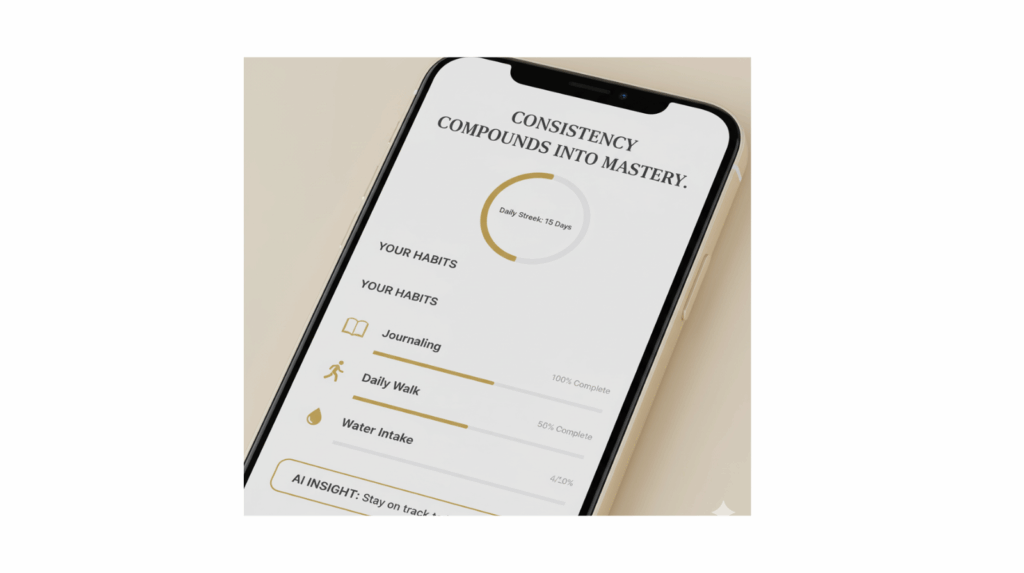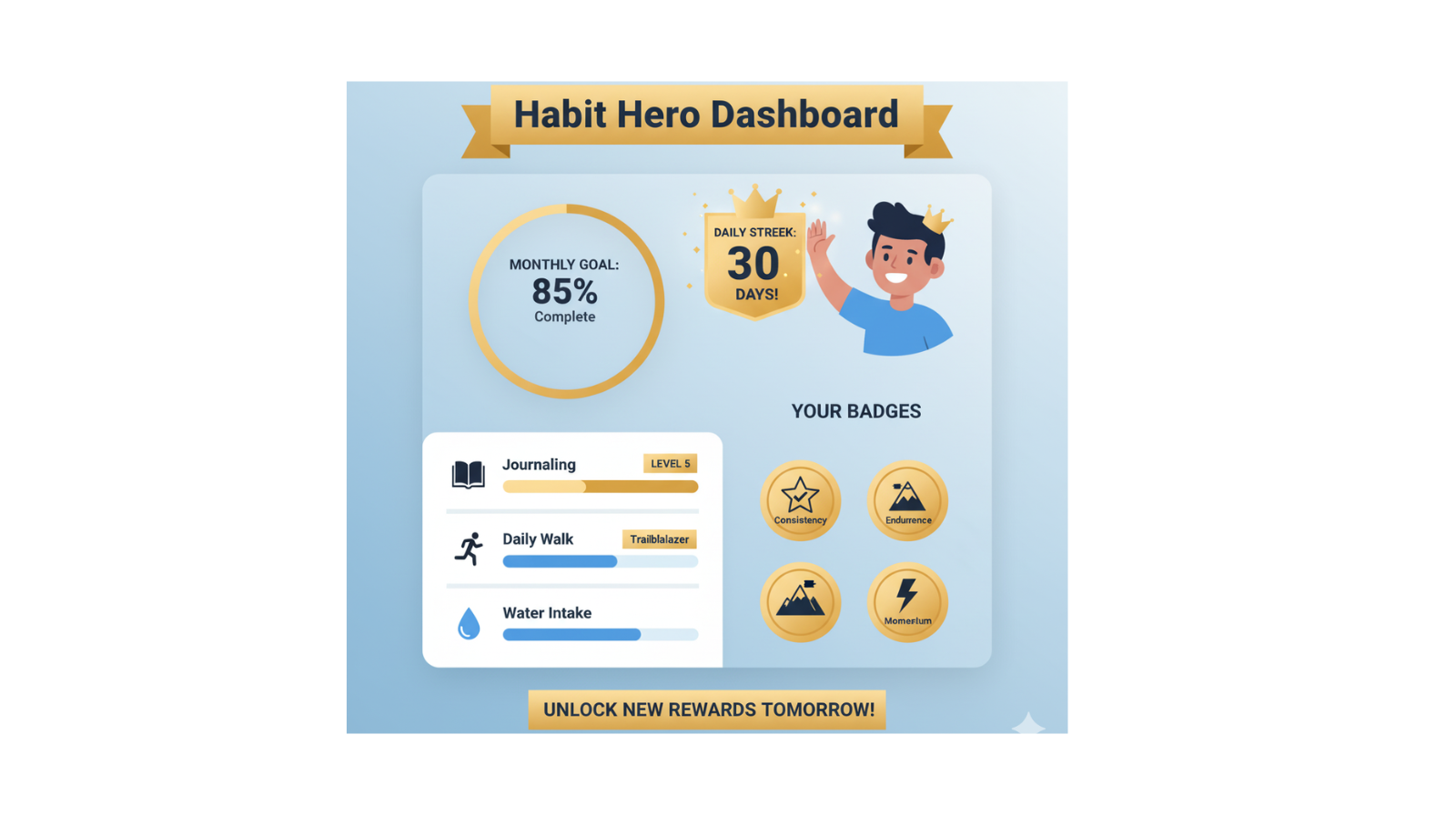You know that rush when you start a new habit — that “this time, I’ve got it” feeling?
And then, two weeks later… poof. Life happens, motivation dips, and you quietly stop tracking.
It’s not a willpower issue. Instead, it’s usually a system issue.
The good news? You can use AI habit tracking to make habits simpler, more visible, and way easier to maintain.
Let’s explore how.
Why Most Habits Don’t Stick
Motivation is like Wi-Fi strong one minute, gone the next. However, systems keep you connected.
The Habit Loop — cue, routine, reward — works best when it’s easy to repeat and hard to forget. Additionally, visible progress matters. When you see a streak light up or a chart fill in, your brain releases dopamine — a natural motivation boost that encourages consistency.
That’s where AI habit tracking comes in. Essentially, it’s like having a calm assistant in your pocket, reminding you to show up and quietly celebrating when you do.
👉 If you want a quick starting point, grab the Free Small Habits Mini Guide. It breaks down the Habit Loop with examples you can use today.
Still, awareness alone won’t change much. You also need feedback — and that’s where AI shines.
How AI Habit Tracking Keeps You Consistent
Consistency isn’t about grinding harder; it’s about seeing progress, even when it feels small.
Thankfully, AI tools handle that part automatically. They track streaks, highlight patterns, and reflect your progress — without judgment.
As a result, you get facts, not guilt.
So, can AI really help?
Yes it can because it gives you gentle nudges, visual proof, and those little dopamine boosts that make consistency feel satisfying instead of stressful.
For instance, tools like Notion AI and Habitica turn progress into a game. Meanwhile, chat-based AIs such as ChatGPT or Gemini can act like accountability partners.
You can literally say:
“Remind me every morning at 8 a.m. to stretch for five minutes,”
and they’ll do it — no judgment, no stress.
If you enjoy journaling, apps like Reflectly or Stoic can help you understand why you stay consistent. Over time, you’ll notice patterns, when energy peaks, when motivation dips, and which days feel easiest.
Ultimately, that kind of awareness builds momentum — and honestly, momentum beats motivation every single time.
Best AI Habit Tracking Apps for Beginners
If you’re new to habit tracking, start simple. These apps make progress easy rather than overwhelming:
- Clockify – Tracks where your time actually goes each day.
- Awesome Habits – Straightforward and guilt-free; includes a handy “Vacation Mode.”
- Habitify – Clean, minimalist, and focused — great if you prefer calm design.
- Habitica – Turns habit-building into a fun game with rewards and challenges.
- Streaks – Ideal for Apple users; syncs seamlessly with Shortcuts and Health data.
Each one offers a slightly different style, so experiment until you find what feels natural.

What Is Habit Stacking (and How AI Fits In)
Habit stacking means linking a new habit to one you already do. Consequently, your routine becomes easier to remember because it rides on an existing cue.
For example: “After I make coffee, I’ll stretch for one minute.”
Then, ask your AI tool to send a reminder at that same time.
By combining automation with psychology, you create a loop that’s both automatic and rewarding.
Small, smart triggers like this build lasting habits much faster than motivation alone.
How AI Adapts to You
Another reason AI tools stand out is adaptability.
They don’t just track data — they learn from it.
When you’re struggling, they suggest smaller steps or longer pauses. Conversely, when you’re consistent, they gently raise the bar.
This adaptive coaching style feels more like a supportive mentor than a digital checklist. As a result, you stay challenged but not overwhelmed — a key factor for sustainable growth.
Taking Breaks from AI Habit Tracking Without Losing Momentum
Let’s be real — life happens. You’ll get sick, travel, or just need a week off.
Thankfully, most AI habit trackers now include Pause or Vacation modes. These features stop your streaks from resetting, helping you take guilt-free breaks.
Because long-term consistency matters more than short-term perfection, those pauses protect your progress without breaking your rhythm.
Pair AI Tracking with Manual Reflection
AI handles tracking, but reflection helps you learn.
Once a week, take five minutes to journal:
- Q1: How can I reflect on what went well this week?
- A1: Write down one or two small wins you’re proud of. Even short moments of progress help you stay motivated.
- Q2: What made habit tracking feel difficult?
- A2: Note any times you resisted or forgot. Seeing patterns helps you adjust your environment or timing next week.
- Q3: Which patterns keep showing up in my habits?
- A3: Review your notes or AI summaries. You’ll start noticing consistent themes—like energy dips, strong times, or triggers worth improving.
Then, ask your AI app to summarise your insights or highlight key themes. Additionally, you can set reminders for daily wellness habits — like gratitude journaling or quick mindfulness breaks.
By pairing data with reflection, you turn habit tracking into self-awareness.
Common Beginner Pitfalls (and How to Avoid Them)
Even with smart tools, people slip into predictable traps:
- Starting too big: Begin with one habit, not five.
- Ignoring reminders: Notifications exist for a reason — use them.
- Expecting instant results: Remember, progress takes patience.
In short, start small, stay curious, and celebrate every win. That’s how mastery builds.
Real People, Real Wins
“I used to set ten goals at once and fail every time. Now I track one habit — a daily walk. Two months later, I actually feel like a different person.” — Amelia, 34
“Clockify showed me how much time I wasted scrolling. Now I use that same hour for workouts. The data doesn’t lie.” — Jordan, 28
These small stories show that success isn’t about doing more — it’s about doing the right things every day.

The Mindset Shift That Makes It All Stick
Ultimately, lasting habits come from systems, not motivation.
Goals point the way forward. However, systems quietly build your identity.
Becoming “the person who journals” or “the one who moves daily” changes you more than hitting any one milestone ever could.
AI habit tracking reinforces that identity by keeping you accountable gently — not critically. In addition, it rewards progress, not perfection.
Each action becomes evidence that you do show up.
Confidence grows from proof, not pressure.
So stop chasing motivation and start trusting your momentum.
If you’re ready to begin, grab the Small Habits Mini Guide over at out sister site. It’s free, short, and genuinely helpful.
When AI Habit Tracking Meets Everyday Mastery
AI won’t build your habits for you — but it can help you keep them.
That’s what we’re all about at Everyday Mastery with AI: using small, smart systems to make meaningful change easier.
Try the Everyday Mastery Coach GPT for daily prompts, or explore the AI Tools Hub for more consistency tools.
Start small. Stay curious.
Build systems that last.